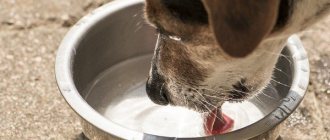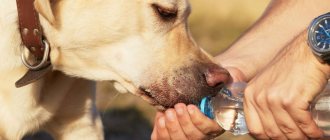- Excessive dog peeing as a normal reflex
- Situations when a dog drinks a lot and pees as a result of illness
What is the reason for frequent bouts of thirst in a dog and frequent urination?
Many owners have to deal with the problem when the dog drinks a lot and urinates a lot, which can be due to either a natural reflex or the development of dangerous diseases.
To distinguish one from the other, you can observe the behavior of your pet and, based on its characteristic signs, recognize whether it is a disease or simply a protective function of the body to some irritant. The information below will help you understand this issue, as it gives a detailed idea of the dog’s unusual behavior.
Causes of frequent urination
The mechanism of fluid intake and urine output is regulated by a system including the kidneys, pituitary gland and hypothalamus. In the anterior part of the hypothalamus there is a thirst center, which, when stimulated, increases fluid consumption. The formation and excretion of urine may increase for a number of reasons:
- kidney disease;
- increased fluid intake;
- pyometra;
- tumors of the brain, lymph nodes;
- excessive formation of antidiuretic hormone in the hypothalamus and pituitary gland.
Most often, the dog begins to drink water heavily as a compensatory reaction due to polyuria . Excessive urine production leads to serious loss of fluid by the body, and the volume of circulating blood decreases. The plasma becomes a hypertonic solution, which irritates the receptors (located in the atria and aortic arch), and turns on the thirst mechanism. Less commonly, thirst in dogs is a primary disease (overheating).
Polyuria is mainly explained by hereditary pathologies. Diabetes insipidus, portal vein anomaly, and hypocortisolism are common in dogs. Tumors of the hypothalamus and pituitary gland are less commonly reported.
Diabetes insipidus
Increased urine production is characteristic of diabetes insipidus. It is caused by a violation of the synthesis of antidiuretic hormone in the endocrine parts of the brain or the inability of the kidneys to respond to the action of this hormone. Central diabetes insipidus is caused by abnormalities in the pituitary gland and hypothalamus. It is rarely observed in young dogs due to congenital pathologies; more often it is associated with acquired pathologies - brain tumors.
Extrinsic or nephrogenic diabetes insipidus in dogs is associated with kidney pathologies when the tubules fail to adequately respond to ADH. Rarely it develops as a genetic disorder. The most common type is secondary or acquired diabetes insipidus, which is associated with various kidney pathologies and metabolic disorders.
Kidney failure
With significant loss of nephrons, dogs develop renal failure. The chronic course is accompanied by a violation of the compensatory function, and polyuria is observed in animals. Kidney failure is associated with various pathological conditions:
- reduction of local blood circulation;
- reduction of the functional surface of nephrons;
- dilation of blood vessels, which leads to a drop in blood pressure;
- damage to the epithelial layer in the kidney tubules;
- kidney stones – cylinders, crystals.
Most often, renal pathology is associated with toxic effects. Anti-inflammatory drugs, aminoglycosides, and chemotherapy drugs are dangerous if misprescribed and used to treat dogs. Less commonly, insufficiency becomes a consequence of a violation of local blood flow - injury, heart disease, fever.
Diagnostics in a veterinary clinic
The veterinarian will examine the dog and send it for blood and urine tests, an ultrasound, and, if necessary or if spinal damage is suspected, for x-rays. In complex cases, it may be necessary to undergo a computed tomography or magnetic resonance imaging scan to clarify the problem and its localization.
Definition of pathology
It is necessary to distinguish between polyuria and pollakiuria in dogs. In the latter case, the amount of urine produced per day does not exceed the norm, but the dog urinates frequently. In this case, a small volume of urine is released, the stream is often interrupted, contains blood, and all this causes pain to the dog. If a dog drinks a lot of water and urinates, there may be more than one reason; it is important to identify it in time in order to prescribe the correct treatment.
The diagnosis is clarified by daily measurement of the volume of fluid consumed and urine excreted. Observations should be carried out over 3-5 days. A laboratory analysis of urine is also carried out - it is important to determine its density. In normal conditions, the density of dog urine is 1.03 kg/l. Pollakiuria allows us to exclude hyperthyroidism, diabetes mellitus, and renal failure in dogs.
Characteristic signs for diabetes mellitus:
- weight loss – the animal is exhausted;
- increased appetite, often perverted;
- increased thirst - dogs drink a lot and often;
- animals begin to pee frequently, increasing the volume of urine excreted.
Laboratory tests are an essential diagnostic tool to accurately make a diagnosis. Determining the level of sodium in the blood plasma will allow us to determine the primary cause - polyuria or thirst. Primary polyuria is characterized by an increase in sodium concentration, polydipsia leads to an increase in blood volume and a relative drop in concentrations.
Hyperadrenocorticism is common in older dogs. It is excluded by determining the level of thyroxine in the blood. A urine test allows you to determine the presence of inflammatory processes in the kidneys. Bacterial culture establishes pyelonephritis.
Lastly, the dog is checked for diabetes insipidus. For this purpose, reduce the amount of fluid consumed and measure the activity of antidiuretic hormone. This test is contraindicated in animals with severe signs of dehydration. With primary polydipsia in dogs, after limiting water drinking, urine output returns to normal. Central diabetes insipidus is characterized by a violation of the concentration of salts in the urine and their normalization after the use of antidiuretic hormone. Nephrogenic diabetes insipidus is characterized by the persistence of the pathological state after the use of ADH.
To perform the test, the dog is restricted from fluids until slight signs of dehydration appear. At the same time, the relative density of urine is measured. The time for the development of dehydration depends on the type and degree of polyuria - in diabetes insipidus it is observed 3-10 hours after the start of the test. Urine samples are taken naturally, but the bladder must be completely emptied for accurate measurements.
In diabetes insipidus, the relative density of urine in a dog is less than 1.03 kg/l.
If urine density is determined below normal levels, a functional test should be continued. The dog is given desmopressin (an antidiuretic hormone). Repeated urine sampling is used to determine its concentration under the influence of hormones. This is necessary to exclude diabetes insipidus of central origin.
Differential diagnosis:
- urinalysis - an increase in protein indicates glomerulonephritis;
- blood biochemistry and general clinical analysis - exclusion of hyperthyroidism, diabetes mellitus, liver and kidney failure;
- biopsy of lymph nodes if calcium levels in the blood increase to exclude tumors;
- X-ray and ultrasound examination of the abdominal cavity to exclude pyometra and endometritis.
With diabetes insipidus in dogs, dry skin and mucous membranes are noted, and turgor decreases. The formation and excretion of urine is increased. The released liquid is transparent and low density. Dogs' saliva is thick and viscous. The temperature is usually within normal limits, but during inflammatory processes in the kidneys it may rise slightly.
The general condition is depressed, sluggish reaction to external stimuli. Dogs develop heart and vascular failure - the heart sounds are muffled, the pulse is rapid with signs of arrhythmia. The respiratory rate is increased with signs of shortness of breath.
How to cure cystitis in a dog?
Treatment of cystitis allows you to eliminate the cause of inflammation (for example, a bacterial infection), restore urinary function and relieve pain in your dog. The course of treatment for the acute form of the disease is 7-10 days, for the chronic form – 14-21 days.
It is based on drug therapy. It includes the following:
- Antibiotics . They are designed to eliminate pathogenic microflora that provoke inflammation of the bladder.
- Analgesics . They are prescribed for intense pain syndrome, characteristic of the acute form of cystitis.
- Drugs that stop bleeding. They are used if blood clots are found in the pet’s urine.
- Antispasmodics. They are designed to facilitate the process of urination and are used for all forms of cystitis.
- Anti-inflammatory drugs. Provide suppression of the inflammatory process and decrease in body temperature.
- Diuretics. They increase urine volume and accelerate the process of eliminating inflammatory microorganisms.
Do not self-medicate. Only a veterinarian who has examined the pet and received the results of laboratory tests (tests) can prescribe medications for the treatment of cystitis in a dog.
Treatment methods
Before the cause of the illness can be determined, emergency assistance should be arranged. Limit drinking, bringing the volume of liquid to the daily norm. It is necessary to control the amount of fluid you drink over a long period. This is often sufficient for the treatment of primary polyuria.
Be sure to review the diet - improper feeding often causes aggravation of the pathology. Salts and proteins are used less in feed - table salt is removed, the proportion of meat and fish, and dairy products is reduced. Fruits and vegetables are more commonly used to feed dogs.
It is important to control not only the volume of liquid, but also the intake of salts. Dogs are given 0.5 grams of table salt per 10 kg of live weight per day. The condition of the skin and mucous membranes should be checked for dehydration. If signs of dehydration appear, infusion therapy is prescribed.
Primary increased thirst cannot be treated with antidiuretic hormones. Any medications should be prescribed with caution until renal and liver failure are excluded from the diagnosis. This especially applies to drugs deposited in the kidney and liver tissues.
Drugs for the treatment of central diabetes insipidus:
- vasopressin;
- pituitrin;
- hypothiazide;
- finlepsin;
- adiuretin.
Norms and deviations in water consumption by a dog
It is considered normal to consume 50-100 ml of liquid per kilogram of weight. Thus, for a 10-kilogram dog, consumption of 1 liter per day would be considered excessive. For a more objective assessment, it is recommended to observe the animal for at least several days. When making calculations, you need to take into account not only water, but all the liquid that enters the body (including with food) - porridge, broth, kefir, yogurt, and so on.
However, this is an average; thirst is influenced by many factors:
- Time of year (dogs drink more in hot weather).
- Activity (the more active, the greater the loss of moisture, and, accordingly, the greater the need for its replenishment).
- Age (puppies drink a lot, as well as old animals, but in the latter case - in small portions).
- Floor . Males drink less in general, and females need more moisture, especially during pregnancy and after it, during lactation.
- Body constitution.
- Wool length.
However, the main criterion (and the simplest) is increasing the amount of water consumed. If your dog begins to drink significantly more than before, it makes sense to understand the reasons.
Features of prevention
The genetic predisposition of some dogs to diabetes insipidus and other metabolic and kidney pathologies cannot be eliminated. It is possible to prevent inflammatory kidney disease in dogs - glomerulonephritis, pyelonephritis:
- proper feeding;
- avoid hypothermia;
- use medications only as prescribed by a veterinarian;
- prevent exposure to household and other poisons;
- promptly treat diseases of the urinary system.
All systems in an animal's body are connected. Therefore, cardiac, respiratory or liver failure often leads to a deterioration in the functioning of the excretory system - the dog urinates on itself and drinks much more. Preventing diseases of other organs will save your pet from kidney damage. Vaccinations and treatments against parasites must be carried out according to the plan. All pathologies must be eliminated at an early stage, and after treatment a course of rehabilitation must be carried out.
Proper feeding is of great importance for the health of your pet. Excess protein and salts in the feed leads to disruption of the nephrons, and filtration capacity decreases. Feeding must be organized taking into account the age, sex and weight of the animal. Proper care will help you get rid of most pathological conditions.
What to do about this problem
First of all, when observing an increase in your dog's water intake, it is worth paying attention to its diet. All salty foods and salt itself should be completely excluded from it. If the feeling of thirst appears after changing the type of food, do not worry too much. In this case, it is only important to provide the animal with a constant supply of fresh, clean water. Over time, the pet will get used to it and return to its previous drinking regime.
If the reason is not food, you should definitely measure her body temperature. If it is elevated, you should seek help from a veterinarian. This symptom often appears at the very first stages of the development of many diseases, which allows them to be influenced in time.
In aging dogs, special attention should be paid to the condition of the liver and kidneys. Often these organs can gradually fail with age. Therefore, the doctor must conduct a full range of various biochemical examinations to determine the degree of functionality of the vital systems of the body.
It is important to note that under no circumstances should you limit your dog’s water intake. His body often does the right thing when it requires a lot of fluid. But there are two exceptions to this rule. They consist in the presence of swelling in the pet’s body, as well as the consumption of water after vomiting. These symptoms indicate quite serious health problems that need to be addressed immediately in a veterinary clinic.
It is worth understanding that an animal’s thirst is often caused by completely harmless reasons that do not require any panic from the pet owner. For example, in childhood, a child can feed the dog chocolates. It is impossible to keep track of this, but the consequences of this “food” intake can lead to an increase in water consumption. That is why you should not be afraid, as this can only lead to inappropriate actions towards your dog.
Briefly about the main thing
- Dogs require water for the normal functioning of their entire body. Lack of fluid leads to slow metabolism, exhaustion and disease.
- Dehydration can be determined by pressing on the gums or by pulling the skin between the shoulder blades.
- The average daily intake for dogs is 20-70 ml per 1 kg of weight. The total volume depends on the weather, lifestyle, and diet.
- If the dog is only eating and refuses water, he needs to be given a rehydration solution or forcefully injected with a syringe.
Has it ever happened to you that your dog refuses to drink at all? Share in the comments how you dealt with this problem.
Injuries
It happens that frequent urination occurs due to pathologies of the spinal column. They are characterized by injury to nerve endings or the spinal canal. It is almost impossible to cure this, at least completely. Usually dogs with an elongated spine suffer from this, for example, dachshunds.
During or after whelping, these dogs sometimes experience nerve compression. This phenomenon is characterized by lethargy of the animal, lack of strength in the paws, and refusal of its own puppy. The doctor will be able to prescribe a combination treatment after diagnosis.
If the doctor insists on surgery, you should not agree right away; let him conduct special tests and prescribe medications.
If a puppy pees
If your puppy urinates frequently, don't scold him. After all, only at 3-4 months will he be able to learn to control this process. The training period may increase if the owner of the four-legged friend cannot correctly explain when and how to do this to the puppy. It is necessary to suggest where to relieve yourself.
If the puppy is already six months old, and he continues to urinate, then you need to think about the seriousness of the situation - perhaps your pet is simply sick, or maybe he has bad heredity. And if this is the reason, then only surgery will help him.
The last stage of senile dementia
In the final stages of dementia, activities of daily living are significantly impaired. The patient requires constant supervision. The gradual deterioration of the mental state reaches such a level that patients cease to understand even the most basic phenomena of life around them:
- speech is almost lost,
- cannot eat food on their own,
- do not distinguish edible from inedible,
- stop observing the rules of personal hygiene,
- do not control bowel movements
- spend most of their time in bed.
Characteristic of the last stage of dementia is being in the fetal position: the legs are bent as much as possible at the knees and hip joints, the arms are crossed on the chest. Patients can remain in this position for days. When trying to change posture, they resist (as much as possible) and emit exclamations similar to moans or screams. All bowel movements are performed “on one’s own behalf.” In this state, patients with dementia do not recognize loved ones and do not respond to external stimuli.
Stages of senile dementia
The progression of thought disorders occurs gradually. There are several periods (stages) that accompany dementia. The following stages of senile dementia are distinguished:
- At the first stage, mild manifestations of signs of degenerative processes are noticeable. Moderate memory impairment occurs. At the same time, the patient can take care of himself, basic types of household activities (cooking, personal hygiene, cleaning) are available to him. The patient retains critical thinking, he is aware of the presence of the disease and is ready for treatment;
- When dementia develops to the second stage, the patient exhibits more severe impairments of memory and intelligence, critical thinking decreases, and the person ceases to realize that he is sick. Difficulties arise when using the telephone, household appliances, a person forgets to turn off the water or gas. At this stage, the patient requires constant supervision, as he may cause harm to himself or his home;
- The third stage is characterized by a strong progression of dementia, in which a complete collapse of the personality occurs. In the last stage of dementia, the ability to think logically is lost. The patient plunges into complete apathy. Such patients require round-the-clock monitoring and care.
Senile dementia: prognosis
With the development of senile dementia, the prognosis will be disappointing. The process is constantly progressing and it is impossible to say exactly when the patient will reach the last stage. Everything is very individual and can take years or months. The patient may reach complete extinction 5-10 years after the onset of the disease.
Patients with senile dementia usually die from diseases that occur in parallel, against the background of complete physical and mental exhaustion. Therefore, to prolong the life of patients and alleviate their condition, doctors at the Yusupov Hospital also treat concomitant diseases.











